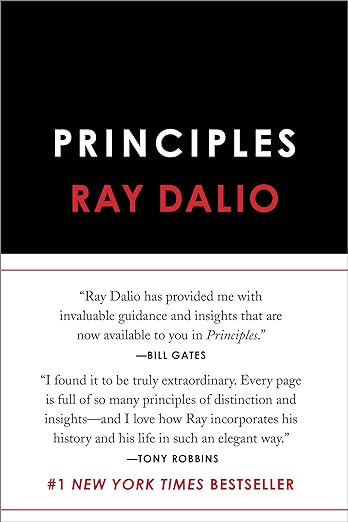Ray Dalio on strengthening your weaknesses (#35)
The billionaire's four ways to bolster shortcomings
In 1982, seven years after he founded Bridgewater Associates— now the largest hedge fund1 in the world—Ray Dalio was nearly, and suddenly, bankrupt.
Dalio made a massive bet on the market that took him within $5,000 of closing up shop—money he’d have to borrow from his father. “I bet everything on a depression that never came,” he told CNBC decades later.
This one event changed Dalio’s system of thinking, and eventually his business. “My thinking went from ‘I’m right’ to ‘How do I know I’m right?’”
And as his thinking changed, he began to document it. Dalio recorded his successful and unsuccessful decisions as “principles”—truths he felt he’d gleaned from guess and check.
In 2011, Dalio turned 30 years worth of these principles into a PDF,2 one that’s been downloaded millions of times. That PDF became the basis of Dalio’s book, Principles: Life and Work.
There are a ton of Thinks in this book, and we’ll get to many of them in the future. But this OGT focuses on Dalio’s simple and unique way to deal with one thing we all have to face:
Our weaknesses.
The book poses an overarching philosophy.
That (1) you need to figure out what you want in life, (2) once you know what that is, you need to figure out how to get there, and (3) the only way you’re going to get there is by being brutally honest about the reality of the world, and the reality of yourself. As Dalio says, you need to embrace the reality of “what you are really like.”
One part of that is figuring out what you’re bad at.
You shouldn’t be upset if you find out that you’re bad at something—you should be happy that you found out, because knowing that and dealing with it will improve your chances of getting what you want.
…But most people lack the courage to confront their own weaknesses and make the hard choices that this process requires.
If you are brave enough, and you figure out some weaknesses, Dalio offers four possible routes you can take:
When encountering your weaknesses you have four choices:
You can deny them (which is what most people do).
You can accept them and work at them in order to try to convert them into strengths (which might or might not work depending on your ability to change).
You can accept your weaknesses and find ways around them.
Or, you can change what you are going after.
He then breaks each one down, starting with what is obviously the worst answer of the four: ignoring them.
The worst path you can take is the first. Denial can only lead to your constantly banging up against your weaknesses, having pain, and not getting anywhere.
He then gets into what he thinks might be the best path, if you can handle it:
The second—accepting your weaknesses while trying to turn them into strengths—is probably the best path if it works. But some things you will never be good at and it takes a lot of time and effort to change. The best single clue as to whether you should go down this path is whether the thing you are trying to do is consistent with your nature (i.e., your natural abilities).
The third option Dalio feels might be common advice, but underutilized.
The third path—accepting your weaknesses while trying to find ways around them—is the easiest and typically the most viable path, yet it is the one least followed…Asking others who are strong in areas where you are weak to help you is a great skill that you should develop no matter what, as it will help you develop guardrails that will prevent you from doing what you shouldn’t be doing. All successful people are good at this.
And four, which is related to how important you think the thing is:
The fourth path, changing what you are going after, is also a great path, though it requires flexibility on your part to get past your preconceptions and enjoy the good fit when you find it.
Of course, key to this entire system is understanding your weaknesses objectively in the first place. First you have to identify them, only then can you decide what to do.
For that, Dalio advises you seek trusted counsel.
Because it is difficult to see oneself objectively, you need to rely on the input of others and the whole body of evidence. I know that my own life has been full of mistakes and lots of great feedback. It was only by looking down on this body of evidence from a higher level that I was able to get around my mistakes and go after what I wanted. For as long as I have been practicing this, I still know I can’t see myself objectively, which is why I continue to rely so much on the input of others.
To help along the way, Dalio offers five guiding tips.
Ultimately, it comes down to the following five decisions:
Don’t confuse what you wish were true with what is really true.
Don’t worry about looking good—worry instead about achieving your goals.
Don’t overweight first-order consequences relative to second- and third-order ones.3
Don’t let pain stand in the way of progress.
Don’t blame bad outcomes on anyone but yourself.
The OGT
There are many that say just focus on strengths.
Tom Rath’s Strengths Finders is based on that notion. Clearly Steve Jobs wasn’t too worried about his weaknesses early in his career (such as treating people poorly).
I think what’s missing from this simplified view is this: how important is the weakness for what you want to do and who you want to be?
Michael Jordan was explosive and a great finisher coming into UNC. He could have just focused on that and been really, really good. But instead he worked on the areas where Dean Smith said he was weak: defense, ball handling, outside jumper. He eventually turned those into strengths, and became the GOAT.
Steve Martin explains that “at age eighteen, [he] had absolutely no gifts.” He wasn’t really that good at performance or comedy naturally, but he learned how to do it over the course of a decade of tiny experiments.
I like Dalio’s nuanced take. That #2—to work at them in order to eventually turn them into strengths— is the best move, but that it’s also hard. In fact, I think it’s the fact that it’s hard is why many say advise focusing on strengths.
Dalio says that turns on this: is it in your nature? I think this is partially right. But I would add one more: even if it doesn’t come naturally to you, how critical is it?
If you want to be a writer, and you’re ‘naturally’ bad at organization (me), you don’t just move on with disorganized thoughts, you work on it, or don’t become a writer.
If you want to be leader, and you’re bad a public speaking or written communication, you probably need to work on that. If you want to marry someone, and you’re not good at what John Gottman calls “the basic mechanism for building trust in a relationship,” you probably want to practice.
For all else, I like #3— hire, or partner with, someone to do it for you, or with you.
Or, there’s always #4: don’t do it.
What do you think?
Sociologist Alfred Jones coined the term in the 1940s. He described the strategy of ‘hedging’ one’s bet against, or favoring, a particular investment. This has, theoretically, the dual benefit of lowering risk of the existing investment, while maximizing profit.
Thanks to Dan Janoff who first pointed me to this PDF in, I want to say 2013 when I was trying to figure out (a) what I wanted to do and (b) investing.
By first-order consequences, Dalio is referring to the short-term consequences of an action. If you eat a piece of lava cake, for example, the first-order consequence is unparalleled bliss. Obviously, Dalio is saying not to overweight that, and instead focus on what will happen down the line—the sugar crash, the unhappiness— and then the third-order— what’s going to happen in 10 years if you keep making this choice?





